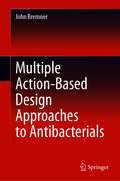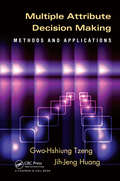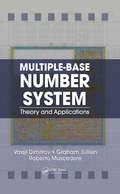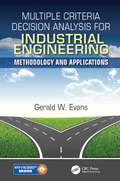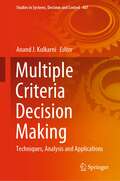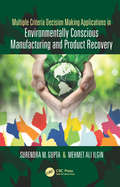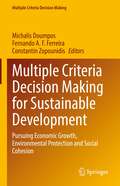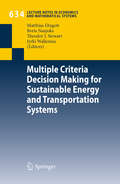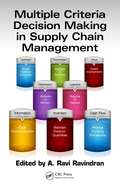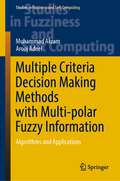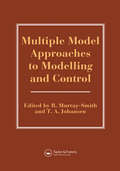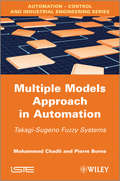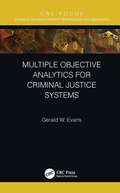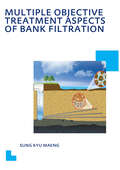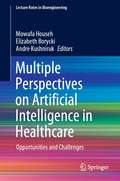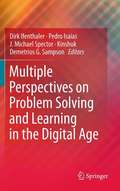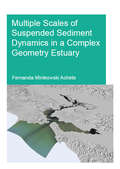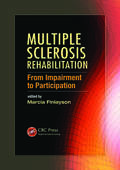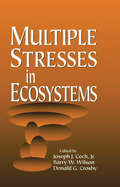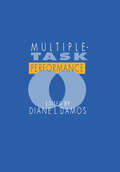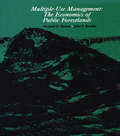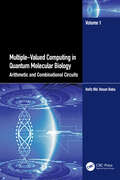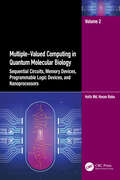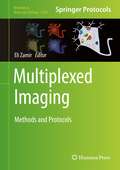- Table View
- List View
Multiple Access Technology Towards Ubiquitous Networks: Overview and Efficient Designs
by Neng Ye Xiangming Li Kai Yang Jianping AnThis book investigates the multiuser communication and its key technology—multiple access technology, as well as transceiving design methods. Multiple access methods toward B5G and 6G currently allows the superposition transmissions of multiuser signals with controllable mutual interference. By deploying advanced multiuser detector, current technology significantly enhances the connectivity, improves the spectral efficiency and simplifies the signaling interactions. Considering that the major challenge of current multiple access technology is the design of transceiver due to the overlapped and distorted signals from multiple users, we analyze the promising candidate multiple access schemes and then develop some sights on how to formulate the transmit signals and how to achieve efficient symbol recovery. Specifically, the incorporation of constellation rotation, rate splitting and deep learning techniques in enhancing the transmission efficiency of multiple access technology are considered.
Multiple Action-Based Design Approaches to Antibacterials
by John BremnerThis book covers intentional design aspects for combinations of drugs, single-molecule hybrids with potential or actual multiple actions, pro-drugs which could yield multiple activity outcomes, and future possibilities. The approach of the book is interdisciplinary, and it provides greater understanding of the complex interplay of factors involved in the medicinal chemistry design and laboratory development of multiply active antibacterials. The scope of the book appeals to readers who are researching in the field of antibacterials using the approach of medicinal chemistry design and drug development.
Multiple Attribute Decision Making: Methods and Applications
by Gwo-Hshiung Tzeng Jih-Jeng HuangDecision makers are often faced with several conflicting alternatives. How do they evaluate trade-offs when there are more than three criteria? To help people make optimal decisions, scholars in the discipline of multiple criteria decision making (MCDM) continue to develop new methods for structuring preferences and determining the correct relative
Multiple-Base Number System: Theory and Applications (Circuits and Electrical Engineering)
by Vassil Dimitrov Graham Jullien Roberto MuscedereComputer arithmetic has become so fundamentally embedded into digital design that many engineers are unaware of the many research advances in the area. As a result, they are losing out on emerging opportunities to optimize its use in targeted applications and technologies. In many cases, easily available standard arithmetic hardware might not necessarily be the most efficient implementation strategy. Multiple-Base Number System: Theory and Applications stands apart from the usual books on computer arithmetic with its concentration on the uses and the mathematical operations associated with the recently introduced multiple-base number system (MBNS). The book identifies and explores several diverse and never-before-considered MBNS applications (and their implementation issues) to enhance computation efficiency, specifically in digital signal processing (DSP) and public key cryptography. Despite the recent development and increasing popularity of MBNS as a specialized tool for high-performance calculations in electronic hardware and other fields, no single text has compiled all the crucial, cutting-edge information engineers need to optimize its use. The authors’ main goal was to disseminate the results of extensive design research—including much of their own—to help the widest possible audience of engineers, computer scientists, and mathematicians. Dedicated to helping readers apply discoveries in advanced integrated circuit technologies, this single reference is packed with a wealth of vital content previously scattered throughout limited-circulation technical and mathematical journals and papers—resources generally accessible only to researchers and designers working in highly specialized fields. Leveling the informational playing field, this resource guides readers through an in-depth analysis of theory, architectural techniques, and the latest research on the subject, subsequently laying the groundwork users require to begin applying MBNS.
Multiple Criteria Decision Analysis for Industrial Engineering: Methodology and Applications (Operations Research Series)
by Gerald William EvansThis textbook presents methodologies and applications associated with multiple criteria decision analysis (MCDA), especially for those students with an interest in industrial engineering. With respect to methodology, the book covers (1) problem structuring methods; (2) methods for ranking multi-dimensional deterministic outcomes including multiattribute value theory, the analytic hierarchy process, the Technique for Order Preference by Similarity to Ideal Solution (TOPSIS), and outranking techniques; (3) goal programming,; (4) methods for describing preference structures over single and multi-dimensional probabilistic outcomes (e.g., utility functions); (5) decision trees and influence diagrams; (6) methods for determining input probability distributions for decision trees, influence diagrams, and general simulation models; and (7) the use of simulation modeling for decision analysis. This textbook also offers: · Easy to follow descriptions of how to apply a wide variety of MCDA techniques · Specific examples involving multiple objectives and/or uncertainty/risk of interest to industrial engineers · A section on outranking techniques ; this group of techniques, which is popular in Europe, is very rarely mentioned as a methodology for MCDA in the United States · A chapter on simulation as a useful tool for MCDA, including ranking & selection procedures. Such material is rarely covered in courses in decision analysis · Both material review questions and problems at the end of each chapter . Solutions to the exercises are found in the Solutions Manual which will be provided along with PowerPoint slides for each chapter. The methodologies are demonstrated through the use of applications of interest to industrial engineers, including those involving product mix optimization, supplier selection, distribution center location and transportation planning, resource allocation and scheduling of a medical clinic, staffing of a call center, quality control, project management, production and inventory control,and so on. Specifically, industrial engineering problems are structured as classical problems in multiple criteria decision analysis, and the relevant methodologies are demonstrated.
Multiple Criteria Decision Making: Techniques, Analysis and Applications (Studies in Systems, Decision and Control #407)
by Anand J. KulkarniThe book discusses state-of-the-art applications and methodologies of the Multiple Criteria Decision Making (MCDM) techniques and approaches. The book focuses on critical literature, underlying principles of methods and models, solution approaches, testing and validation, real-world applications, case studies, etc. The book helps evaluate strategic decision-making through advanced MCDM and integrated approaches of AI, big data, and IoT to provide realistic and robust solutions to the current problems. The book will be a guideline to the potential MCDM researchers about the choice of approaches for dealing with the complexities and modalities. The contributions of the book help readers to explore new avenues leading towards multidisciplinary research discussions. This book will be interesting for engineers, scientists, and students studying/working in the related areas.
Multiple Criteria Decision Making Applications in Environmentally Conscious Manufacturing and Product Recovery
by Surendra M. Gupta Mehmet Ali IlginIn order to ensure environmentally responsible production and disposal of products, local governments are imposing stricter environmental regulations, some of which even require manufacturers to take back their products at the end of the product's useful life. These government regulations, together with increasing environmental awareness, have forced manufacturers to invest in environment-conscious manufacturing. The multiple Criteria Decision Making Techniques presented in this book can be employed to solve the problems of environment-conscious manufacturers in product design, logistics, disassembly and remanufacturing.
Multiple Criteria Decision Making for Sustainable Development: Pursuing Economic Growth, Environmental Protection and Social Cohesion (Multiple Criteria Decision Making)
by Michalis Doumpos Fernando A. F. Ferreira Constantin ZopounidisThis book presents a rich collection of studies on the analysis of sustainable development from a multiple criteria decision-making (MCDM) perspective, written by some of the most prominent authors in the field of MCDM/A. The book constitutes a unique international reference guide to the analysis, measurement, and management of sustainability in a multidimensional decision analysis context. Chiefly intended for academics and policymakers, it reflects some of the latest methodological advances in decision-making, which are illustrated in real-life applications to sustainability-related topics in both the private and public sector.
Multiple Criteria Decision Making for Sustainable Energy and Transportation Systems
by Theodor Stewart Jyrki Wallenius Boris Naujoks Matthias EhrgottIn the twenty-first century the sustainability of energy and transportation systems is on the top of the political agenda in many countries around the world. Environmental impacts of human economic activity necessitate the consideration of conflicting goals in decision making processes to develop sustainable systems. Any sustainable development has to reconcile conflicting economic and environmental objectives and criteria. The science of multiple criteria decision making has a lot to offer in addressing this need. Decision making with multiple (conflicting) criteria is the topic of research that is at the heart of the International Society of Multiple Criteria Decision Making. This book is based on selected papers presented at the societies 19th International Conference, held at The University of Auckland, New Zealand, from 7th to 12th January 2008 under the theme "MCDM for Sustainable Energy and Transportation Systems''.
Multiple Criteria Decision Making in Supply Chain Management (Operations Research Series)
by A. Ravi RavindranSupply chain management decisions are made under the conflicting criteria of maximizing profit and customer responsiveness while minimizing supply chain risk. Multiple Criteria Decision Making in Supply Chain Management provides a comprehensive overview of multi-criteria optimization models and methods that can be used in supply chain decision making.Presenting the contributions of internationally known authors, researchers, educators, and practitioners, this new book in the Operations Research Series provides readers with a single source guide to recent developments in this area. The focus of the book is on the design and operation of the supply chain system, which involves connecting many production and distribution systems, often across wide geographic distances, in such a way that the businesses involved can ultimately satisfy the consumer demand as efficiently as possible, resulting in maximum financial returns to those businesses connected to that supply chain system. The book includes several case studies on the design and operation of supply chain networks in manufacturing and healthcare.
Multiple Criteria Decision Making Methods with Multi-polar Fuzzy Information: Algorithms and Applications (Studies in Fuzziness and Soft Computing #430)
by Muhammad Akram Arooj AdeelThis book presents an extension of fuzzy set theory allowing for multi-polar information, discussing its impact on the theoretical and practical development of multi-criteria decision making. It reports on set of hybrid models developed by the authors, and show how they can be adapted, case by case, to the lack of certainty under a variety of criteria. Among them, hybrid models combining m-polar fuzzy sets with rough, soft and 2-tuple linguistic sets, and m-polar hesitant fuzzy sets and hesitant m-polar fuzzy are presented, together with some significant applications. In turn, outranking decision-making techniques such as m-polar fuzzy ELECTRE I, II, III and IV methods, as well as m-polar fuzzy PROMETHEE I and II methods, are developed. The efficiency of these decision-making procedures, as well as other possible extensions studied by the authors, is shown in some real-world applications. Overall, this book offers a guide on methodologies to deal with the multi-polarity and fuzziness of the real-world problems, simultaneously. By including algorithms and computer programming codes, it provides a practice-oriented reference guide to both researchers and professionals working at the interface between computational intelligence and decision making.
Multiple Model Approaches To Nonlinear Modelling And Control
by R. Murray-Smith T. JohansenThis work presents approaches to modelling and control problems arising from conditions of ever increasing nonlinearity and complexity. It prescribes an approach that covers a wide range of methods being combined to provide multiple model solutions. Many component methods are described, as well as discussion of the strategies available for building a successful multiple model approach.
Multiple Models Approach in Automation: Takagi-Sugeno Fuzzy Systems (Wiley-iste Ser.)
by Mohammed Chadli Pierre BorneMuch work on analysis and synthesis problems relating to the multiple model approach has already been undertaken. This has been motivated by the desire to establish the problems of control law synthesis and full state estimation in numerical terms. In recent years, a general approach based on multiple LTI models (linear or affine) around various function points has been proposed. This so-called multiple model approach is a convex polytopic representation, which can be obtained either directly from a nonlinear mathematical model, through mathematical transformation or through linearization around various function points. This book concentrates on the analysis of the stability and synthesis of control laws and observations for multiple models. The authors’ approach is essentially based on Lyapunov’s second method and LMI formulation. Uncertain multiple models with unknown inputs are studied and quadratic and non-quadratic Lyapunov functions are also considered.
Multiple Objective Analytics for Criminal Justice Systems (Emerging Operations Research Methodologies and Applications)
by Gerald W. EvansCriminal justice systems are complex and difficult to design and operate. This is due to their many interacting parts, and their dynamic and probabilistic nature, as well as their interfaces with other systems. This book reviews the use of analytics to address issues in criminal justice system and discusses the various sources of data associated with the systems. This book is meant to be used by those who would like 1) an introduction to criminal justice systems and 2) an illustration of how some of the various methodologies of analytics can be used to address specific issues in criminal justice systems. This book will be of interest to faculty, students, and researchers in schools/departments of criminal justice, law, public affairs, political science, industrial engineering, and management. In addition, the book should be of use to government analysts who study the effects of criminal programs and laws.
Multiple Objective Treatment Aspects of Bank Filtration: Unesco-ihe Phd Thesis
by Sung Kyu MaengBank filtration (BF) is a natural water treatment process which induces surface water to flow in response to a hydraulic gradient through soil/sediment and into a vertical or horizontal well. It is a relatively cost-effective, robust and sustainable technology. From a historical perspective, BF is first mentioned in the bible, and the process has been recognized as a proven method for drinking water treatment in Europe for more than 100 years. However, the mechanisms of removal of different contaminants during BF are not fully understood. This study showed that BF is an effective multiple objective barrier for removal of different contaminants present in surface water sources including bulk organic matter and organic micropollutants (OMPs) like pharmaceutically active compounds and endocrine disrupting compounds. It was found that biodegradation and adsorption play primary and secondary roles, respectively, in the removal of OMPs during soil passage. Furthermore, using field data from BF sites and chemical properties of OMPs, models were developed to estimate the removal of OMPs during soil passage. It can be concluded that the removal efficiencies of BF for these contaminants can be maximised by proper design and operation of recovery wells taking into consideration source water quality characteristics and local hydrogeological conditions.
Multiple Perspectives on Artificial Intelligence in Healthcare: Opportunities and Challenges (Lecture Notes in Bioengineering)
by Mowafa Househ Elizabeth Borycki Andre KushnirukThis book offers a comprehensive yet concise overview of the challenges and opportunities presented by the use of artificial intelligence in healthcare. It does so by approaching the topic from multiple perspectives, e.g. the nursing, consumer, medical practitioner, healthcare manager, and data analyst perspective. It covers human factors research, discusses patient safety issues, and addresses ethical challenges, as well as important policy issues. By reporting on cutting-edge research and hands-on experience, the book offers an insightful reference guide for health information technology professionals, healthcare managers, healthcare practitioners, and patients alike, aiding them in their decision-making processes. It will also benefit students and researchers whose work involves artificial intelligence-related research issues in healthcare.
Multiple Perspectives on Problem Solving and Learning in the Digital Age
by Dirk Ifenthaler J. Michael Spector Kinshuk Pedro Isaias Demetrios G. SampsonThis edited volume with selected expanded papers from CELDA (Cognition and Exploratory Learning in the Digital Age) 2009 (http://www.celda-conf.org/) addresses the main issues concerned with problem solving, evolving learning processes, innovative pedagogies, and technology-based educational applications in the digital age. There have been advances in both cognitive psychology and computing that have affected the educational arena. The convergence of these two disciplines is increasing at a fast pace and affecting academia and professional practice in many ways. Paradigms such as just-in-time learning, constructivism, student-centered learning and collaborative approaches have emerged and are being supported by technological advancements such as simulations, virtual reality and multi-agents systems. These developments have created both opportunities and areas of serious concerns. This volume aims to cover both technological as well as pedagogical issues related to these developments.
Multiple Scales of Suspended Sediment Dynamics in a Complex Geometry Estuary (IHE Delft PhD Thesis Series)
by Fernanda Minikowski AcheteMany estuaries are located in urbanized, highly engineered environments. Cohesive sediment plays an important role due to its link with estuarine health and ecology. An important ecological parameter is the suspended sediment concentration (SSC) translated into turbidity levels and sediment budget. This study contributes to investigate and forecast turbidity levels and sediment budget variability at San Francisco Bay-Delta system at a variety of spatial and temporal scales applying a flexible mesh process-based model (Delft3D FM). It is possible to have a robust sediment model, which reproduces 90% of the yearly data derived sediment budget, with simple model settings, like applying one mud fraction and a simple bottom sediment distribution. This finding opens the horizon for modeling less monitored estuaries.Comparing two case studies, i.e. the Sacramento-San Joaquin Delta and Alviso Slough, a classification for estuaries regarding the main sediment dynamic forcing is proposed: event-driven estuary (Delta) and tide-driven estuary (Alviso Slough). In the event-driven estuaries, the rivers are the main sediment source and the tides have minor impact in the net sediment transport. In the tide-driven estuaries, the main sediment source is the bottom sediment and the tide asymmetry defines the net sediment transport.This research also makes advances in connecting different scientific fields and developing a managerial tool to support decision making. It provides the basis to a chain of models, which goes from the hydrodynamics, to suspended sediment, to phytoplankton, to fish, clams and marshes.
Multiple Sclerosis Rehabilitation: From Impairment to Participation (Rehabilitation Science in Practice Series)
by Marcia Finlayson"MS is always in the back of your mind. If there is something you want to do, you always wonder if the MS will allow you do to it."-Darlene, living with MS for 22 yearsLiving with multiple sclerosis (MS) is challenging and multidimensional. MS pervades all aspects of life: one's body becomes unpredictable and unreliable, one's identity and sense of
Multiple Stresses in Ecosystems
by Jr. Cech Barry W. Wilson Donald G. CrosbyEcotoxicology is the evaluation of toxic effects within the environment, typically within one specific ecosystem, like a forest, stream, or lake. For years now, ecotoxicological studies have tended to focus on one toxicant at a time. But that isn't how an ecosystem encounters toxicants (or stresses): there may be several elements at work in the air, several more in the water, and still more already within the soil of any given ecosystem, and all have some level of toxic influence on that ecosystem. Multiple Stresses in Ecosystems presents the state-of-the-art in determining the effects of these multiple impacts upon ecosystems.Resulting from a vanguard conference originally held in 1993 at UC Davis, this new work is divided into three sections that present methodolgies for assessing the health of an ecosystem; the effects of multiple toxicological impacts upon an ecosystem, and which tools are worth using to assess these dangers. Environmental scientists, chemists, toxicologists, risk analysts, and probably the entire membership of SETAC will find need for this book, as will wetlands scientists, ecologists, and research biologists.
Multiple Task Performance
by Diane L. DamosThis book deals with theories of multiple-task performance and focuses on learning and performance. It is primarily for professionals in human factors, psychology, or engineering who are interested in multiple-task performance but have no formal training in the area.
Multiple-Use Management: The Economics of Public Forestlands
by Michael D. Bowes John V. KrutillaIn this book, Bowes and Krutilla bring together what is known and relevant about valuing the nonmarket services of the public forests and propose a new theoretical framework that allows multiple uses, the biological dynamics of the forest, and the institutional and economic realities of public forest management to be taken into account in forest planning and budgeting. The authors begin by tracing the development of multiple use in forest management and by exploring the multiple uses of the public forests and the economics of multiple-use forestry. They offer a masterful analysis of the nineteenth-century model of the single timber stand on which much forestry practice has been premised. Bowes and Krutilla then take a giant step forward by developing a larger theoretical framework and showing how forest structure and dynamics can be included in the economic model. The authors' rigorous exposition theory provides the foundation for analyzing case studies of management for timber and water yields in the Rockies, of recreation valuation in the Black Hills and White Mountain national forests, and of joint production in the White Clouds Peaks --- analyses that demonstrate the authors' great skill in developing practical methodologies to meet actual forest management problems.
Multiple-Valued Computing in Quantum Molecular Biology: Arithmetic and Combinational Circuits
by Hafiz Md. BabuThis book focuses on the design methodologies of various quantum circuits, DNA circuits, DNA-quantum circuits and quantum-DNA circuits. It considers the merits and challenges of multivalued logic circuits in quantum, DNA, quantum-DNA and DNA-quantum computing. Multiple-Valued Computing in Quantum Molecular Biology: Arithmetic and Combinational Circuits is Volume 1 of a two-volume set. From fundamentals to advanced levels, this book discusses different multiple-valued logic DNA-quantum and quantum-DNA circuits. The text consists of four parts. Part I introduces multiple-valued quantum computing and DNA computing. It contains the basic understanding of multiple-valued quantum computing, multiple-valued DNA computing, multiple-valued quantum-DNA computing and multiple-valued DNA-quantum computing. Part II examines heat calculation, speed calculation, heat transfer, data conversion and data management in multi-valued quantum, DNA, quantum-DNA and DNA-quantum computing. Part III discusses multiple-valued logic operations in quantum and DNA computing such as ternary AND, NAND, OR, NOR, XOR, XNOR and multiple-valued arithmetic operations such as adder, multiplier, divider and more. Quantum-DNA and DNA-quantum multiple-valued arithmetic operations are also explained in this section. Part IV explains multiple-valued quantum and DNA combinational circuits such as multiple-valued DNA-quantum and quantum-DNA multiplexer, demultiplexer, encoder and decoder. This book will be of great help to researchers and students in quantum computing, DNA computing, quantum-DNA computing and DNA-quantum computing researchers.
Multiple-Valued Computing in Quantum Molecular Biology: Sequential Circuits, Memory Devices, Programmable Logic Devices, and Nanoprocessors
by Hafiz Md. BabuThis book mainly focuses on the design methodologies of various quantum circuits, DNA circuits, DNA-quantum circuits, and quantum-DNA circuits. In this text, the author has compiled various design aspects of multiple-valued logic DNA-quantum and quantum-DNA sequential circuits, memory devices, programmable logic devices, and nanoprocessors. Multiple-Valued Computing in Quantum Molecular Biology: Sequential Circuits, Memory Devices, Programmable Logic Devices, and Nanoprocessors is Volume 2 of a two-volume set, and consists of four parts. This book presents various design aspects of multiple-valued logic DNA-quantum and quantum-DNA sequential circuits, memory devices, programmable logic devices, and nanoprocessors. Part I discusses multiple-valued quantum and DNA sequential circuits such as D flip-flop, SR latch, SR flip-flop, JK flip-flop, T flip-flop, shift register, ripple counter, and synchronous counter, which are described, respectively, with the applications and working procedures. After that, multiple-valued quantum-DNA and DNA-quantum sequential circuits such as D flip-flop, SR flip-flop, JK flip-flop, T flip-flop, shift register, ripple counter and synchronous counter circuits are explained with working procedures and architecture. Part II discusses the architecture and design procedure of memory devices such as random access memory (RAM), read-only memory (ROM), programmable read-only memory (PROM), and cache memory, which are sequentially described in multiple-valued quantum, DNA, quantum-DNA, and DNA-quantum computing. In Part III, the author examines the architectures and working principles of programmable logic devices such as programmable logic array (PLA), programmable array logic (PAL), field programmable gate array (FPGA), and complex programmable logic device (CPLD) in multiple-valued quantum, DNA, quantum-DNA, and DNA-quantum computing. Multiple-valued quantum, DNA, quantum-DNA, and DNA-quantum nanoprocessors are designed with algorithms in Part IV. Furthermore, the basic components of ternary nanoprocessors such as T-RAM, ternary instruction register, ternary incrementor circuit, ternary decoder, ternary multiplexer, ternary accumulator in quantum, DNA, quantum-DNA, and DNA-quantum computing are also explained in detail. This book will be of great help to researchers and students in quantum computing, DNA computing, quantum-DNA computing, and DNA-quantum computing.
Multiplexed Imaging: Methods and Protocols (Methods in Molecular Biology #2350)
by Eli ZamirThis volume provides a collection of state-of-the-art approaches addressing key aspects of multiplexed imaging. Chapters focus on labeling and imaging techniques for multiplexed imaging, as well as on the application of these techniques for the study of cells and tissues. Written in the highly successful Methods in Molecular Biology series format, chapters include introductions to their respective topics, lists of the necessary materials and reagents, step-by-step, readily reproducible laboratory protocols, and tips on troubleshooting and avoiding known pitfalls. Authoritative and practical, Multiplexed Imaging: Methods and Protocols aims to be helpful for researchers interested in implementing multiplexed imaging or in developing novel, cutting-edge multiplexed imaging approaches.

